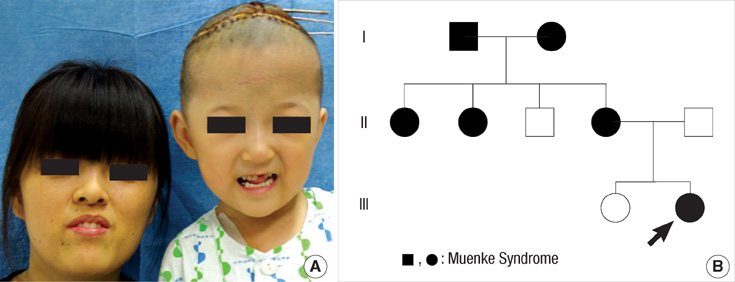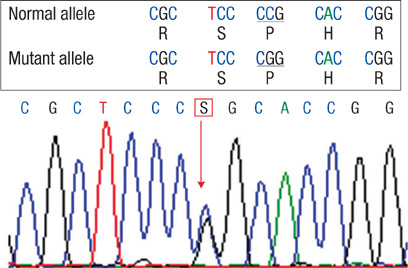J Korean Med Sci.
2010 Jul;25(7):1086-1089. 10.3346/jkms.2010.25.7.1086.
A Korean Family with the Muenke Syndrome
- Affiliations
-
- 1Department of Pediatrics, Ajou University School of Medicine, Suwon, Korea.
- 2Department of Plastic and Reconstructive Surgery, Ajou University School of Medicine, Suwon, Korea.
- 3Department of Neurosurgery, Ajou University School of Medicine, Suwon, Korea. ee80@ajou.ac.kr
- KMID: 1792963
- DOI: http://doi.org/10.3346/jkms.2010.25.7.1086
Abstract
- The Muenke syndrome (MS) is characterized by unicoronal or bicoronal craniosynostosis, midfacial hypoplasia, ocular hypertelorism, and a variety of minor abnormalities associated with a mutation in the fibroblast growth factor receptor 3 (FGFR3) gene. The birth prevalence is approximately one in 10,000 live births, accounting for 8-10% of patients with coronal synostosis. Although MS is a relatively common diagnosis in patients with craniosynostosis syndromes, with autosomal dominant inheritance, there has been no report of MS, in an affected Korean family with typical cephalo-facial morphology that has been confirmed by molecular studies. Here, we report a familial case of MS in a female patient with a Pro250Arg mutation in exon 7 (IgII-IGIII linker domain) of the FGFR3 gene. This patient had mild midfacial hypoplasia, hypertelorism, downslanting palpebral fissures, a beak shaped nose, plagio-brachycephaly, and mild neurodevelopmental delay. The same mutation was confirmed in the patient's mother, two of the mother's sisters and the maternal grandfather. The severity of the cephalo-facial anomalies was variable among these family members.
MeSH Terms
Figure
Reference
-
1. Bellus GA, Gaudenz K, Zackai EH, Clarke LA, Szabo J, Francomano CA, Muenke M. Identical mutations in three different fibroblast growth factor receptor genes in autosomal dominant craniosynostosis syndromes. Nat Genet. 1996. 14:174–176.
Article2. Muenke M, Gripp KW, McDonald-McGinn DM, Gaudenz K, Whitaker LA, Bartlett SP, Markowitz RI, Robin NH, Nwokoro N, Mulvihill JJ, Losken HW, Mulliken JB, Guttmacher AE, Wilroy RS, Clarke LA, Hollway G, Adès LC, Haan EA, Mulley JC, Cohen MM Jr, Bellus GA, Francomano CA, Moloney DM, Wall SA, Wilkie AO. A unique point mutation in the fibroblast growth factor receptor 3 gene (FGFR3) defines a new craniosynostosis syndrome. Am J Hum Genet. 1997. 60:555–564.3. Doherty ES, Lacbawan F, Hadley DW, Brewer C, Zalewski C, Kim HJ, Solomon B, Rosenbaum K, Domingo DL, Hart TC, Brooks BP, Immken L, Lowry RB, Kimonis V, Shanske AL, Jehee FS, Bueno MR, Knightly C, McDonald-McGinn D, Zackai EH, Muenke M. Muenke syndrome (FGFR3-related craniosynostosis): expansion of the phenotype and review of the literature. Am J Med Genet A. 2007. 143A:3204–3215.
Article4. Moloney DM, Wall SA, Ashworth GJ, Oldridge M, Glass IA, Francomano CA, Muenke M, Wilkie AO. Prevalence of Pro250Arg mutation of fibroblast growth factor receptor 3 in coronal craniosynostosis. Lancet. 1997. 349:1059–1062.
Article5. Nachman MW, Crowell SL. Estimate of the mutation rate per nucleotide in humans. Genetics. 2000. 156:297–304.
Article6. Mulliken JB, Steinberger D, Kunze S, Müller U. Molecular diagnosis of bilateral coronal synostosis. Plast Reconstr Surg. 1999. 104:1603–1615.
Article7. Cunningham ML, Seto ML, Ratisoontorn C, Heike CL, Hing AV. Syndromic craniosynostosis: from history to hydrogen bonds. Orthod Craniofac Res. 2007. 10:67–81.
Article8. Kimonis V, Gold JA, Hoffman TL, Panchal J, Boyadjiev SA. Genetics of craniosynostosis. Semin Pediatr Neurol. 2007. 14:150–161.
Article9. Kan SH, Elanko N, Johnson D, Cornejo-Roldan L, Cook J, Reich EW, Tomkins S, Verloes A, Twigg SR, Rannan-Eliya S, McDonald-McGinn DM, Zackai EH, Wall SA, Muenke M, Wilkie AO. Genomic screening of fibroblast growth-factor receptor 2 reveals a wide spectrum of mutations in patients with syndromic craniosynostosis. Am J Hum Genet. 2002. 70:472–486.
Article10. Passos-Bueno MR, Serti Eacute AE, Jehee FS, Fanganiello R, Yeh E. Genetics of craniosynostosis: genes, syndromes, mutations and genotype-phenotype correlations. Front Oral Biol. 2008. 12:107–143.
Article11. Lajeunie E, El Ghouzzi V, Le Merrer M, Munnich A, Bonaventure J, Renier D. Sex related expressivity of the phenotype in coronal craniosynostosis caused by the recurrent P250R FGFR3 mutation. J Med Genet. 1999. 36:9–13.12. Schindler S, Friedrich M, Wagener H, Lorenz B, Preising MN. Heterozygous P250L mutation of fibroblast growth factor receptor 3 in a case of isolated craniosynostosis. J Med Genet. 2002. 39:764–766.
Article13. Hollway GE, Suthers GK, Battese KM, Turner AM, David DJ, Mulley JC. Deafness due to Pro250Arg mutation of FGFR3. Lancet. 1998. 351:877–878.
Article14. Keller MK, Hermann NV, Darvann TA, Larsen P, Hove HD, Christensen L, Schwartz M, Marsh JL, Kreiborg S. Craniofacial morphology in Muenke syndrome. J Craniofac Surg. 2007. 18:374–386.
Article15. Reardon W, Wilkes D, Rutland P, Pulleyn LJ, Malcolm S, Dean JC, Evans RD, Jones BM, Hayward R, Hall CM, Nevin NC, Baraister M, Winter RM. Craniosynostosis associated with FGFR3 pro250arg mutation results in a range of clinical presentations including unisutural sporadic craniosynostosis. J Med Genet. 1997. 34:632–636.
Article16. Graham JM Jr, Braddock SR, Mortier GR, Lachman R, Van Dop C, Jabs EW. Syndrome of coronal craniosynostosis with brachydactyly and carpal/tarsal coalition due to Pro250Arg mutation in FGFR3 gene. Am J Med Genet. 1998. 77:322–329.
Article17. Grosso S, Farnetani MA, Berardi R, Bartalini G, Carpentieri M, Galluzzi P, Mostardini R, Morgese G, Balestri P. Medial temporal lobe dysgenesis in Muenke syndrome and hypochondroplasia. Am J Med Genet A. 2003. 120:88–91.
Article18. Ogle RC, Tholpady SS, McGlynn KA, Ogle RA. Regulation of cranial suture morphogenesis. Cell Tissues Organs. 2004. 176:54–66.
Article19. Opperman LA. Cranial sutures as intramembranous bone growth sites. Dev Dyn. 2000. 219:472–485.
Article20. Marie PJ, Coffin JD, Hurley MM. FGF and FGFR signaling in chondrodysplasias and craniosynostosis. J Cell Biochem. 2005. 96:888–896.
Article21. Mohammadi M, Olsen SK, Ibrahimi OA. Structural basis for fibroblast growth factor receptor activation. Cytokine Growth Factor Rev. 2005. 16:107–137.
Article




